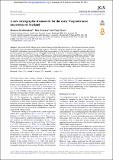Files in this item
A new stratigraphic framework for the early Neoproterozoic successions of Scotland
Item metadata
| dc.contributor.author | Krabbendam, Maarten | |
| dc.contributor.author | Strachan, Rob | |
| dc.contributor.author | Prave, Tony | |
| dc.date.accessioned | 2021-10-18T14:30:32Z | |
| dc.date.available | 2021-10-18T14:30:32Z | |
| dc.date.issued | 2021-10-06 | |
| dc.identifier | 275615976 | |
| dc.identifier | db3c12a8-01f4-445d-ac99-96ab7bb582cf | |
| dc.identifier | 000756696700001 | |
| dc.identifier | 85116711475 | |
| dc.identifier.citation | Krabbendam , M , Strachan , R & Prave , T 2021 , ' A new stratigraphic framework for the early Neoproterozoic successions of Scotland ' , Journal of the Geological Society , vol. Online First . https://doi.org/10.1144/jgs2021-054 | en |
| dc.identifier.issn | 0016-7649 | |
| dc.identifier.other | ORCID: /0000-0002-4614-3774/work/101958333 | |
| dc.identifier.uri | https://hdl.handle.net/10023/24155 | |
| dc.description.abstract | The circum-North Atlantic region archives three major late-Mesoproterozoic to Neoproterozoic tectonic episodes, the Grenville-Sveconorwegian and Renlandian orogenies followed by rifting and formation of the Iapetus Ocean, and each is bracketed by sedimentary successions that define three megasequences. In this context, we summarise sedimentological and geochronological data and propose a new stratigraphic framework for the iconic Torridonian-Moine-Dalradian successions and related units in Scotland. The Iona, Sleat, Torridon and Morar groups of the Scottish mainland and Inner Hebrides, and the Westing, Sand Voe and Yell Sound groups in Shetland, form the newly named Wester Ross Supergroup. They were deposited c. 1000–950 Ma within a foreland basin to the Grenville Orogen and, collectively, are in Megasequence 1. Some of these units record Renlandian orogenesis at c. 960-920 Ma. The newly named Loch Ness Supergroup consists of the Glenfinnan, Loch Eil and Badenoch groups of the Scottish mainland, deposited c. 900–870 Ma and are assigned to Megasequence 2. These units record Knoydartian orogenesis c. 820-725 Ma. The regionally extensive Dalradian Supergroup belongs to Megasequence 3; it was deposited c. <725-500 Ma and records the opening of the Iapetus Ocean, ultimately leading to deposition of the passive margin Cambrian-Ordovician Ardvreck and Durness groups. | |
| dc.format.extent | 16 | |
| dc.format.extent | 9363006 | |
| dc.language.iso | eng | |
| dc.relation.ispartof | Journal of the Geological Society | en |
| dc.subject | DA Great Britain | en |
| dc.subject | QE Geology | en |
| dc.subject | T-DAS | en |
| dc.subject.lcc | DA | en |
| dc.subject.lcc | QE | en |
| dc.title | A new stratigraphic framework for the early Neoproterozoic successions of Scotland | en |
| dc.type | Journal article | en |
| dc.contributor.institution | University of St Andrews. School of Earth & Environmental Sciences | en |
| dc.contributor.institution | University of St Andrews. Marine Alliance for Science & Technology Scotland | en |
| dc.contributor.institution | University of St Andrews. Scottish Oceans Institute | en |
| dc.contributor.institution | University of St Andrews. St Andrews Sustainability Institute | en |
| dc.contributor.institution | University of St Andrews. St Andrews Isotope Geochemistry | en |
| dc.identifier.doi | 10.1144/jgs2021-054 | |
| dc.description.status | Peer reviewed | en |
| dc.date.embargoedUntil | 2021-10-06 | |
| dc.identifier.url | https://jgs.lyellcollection.org/content/early/2021/08/25/jgs2021-054 | en |
This item appears in the following Collection(s)
Items in the St Andrews Research Repository are protected by copyright, with all rights reserved, unless otherwise indicated.

